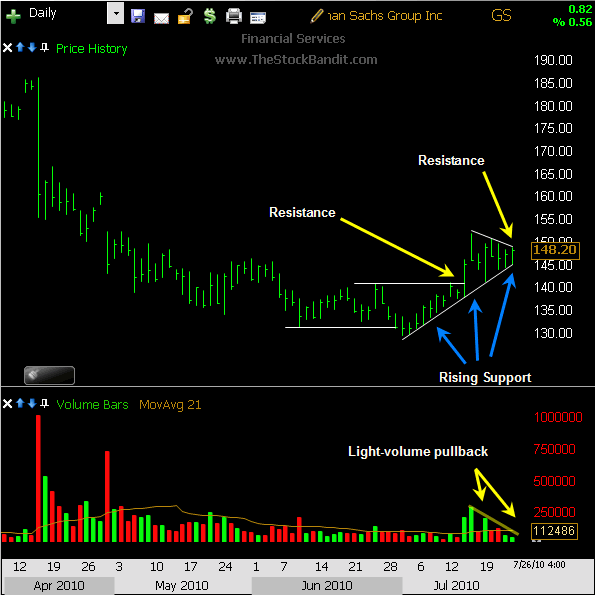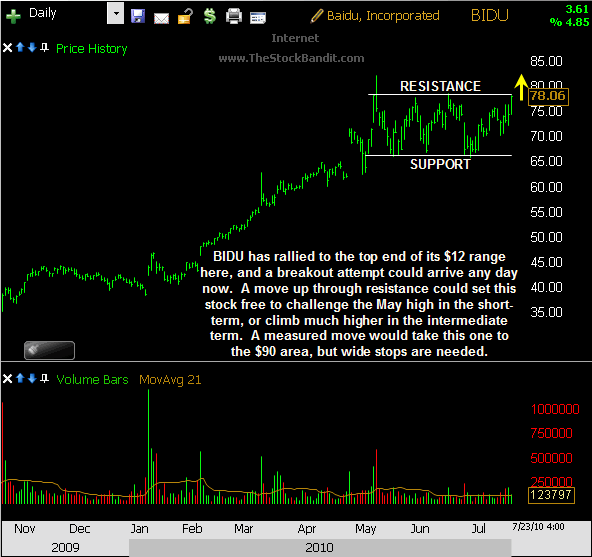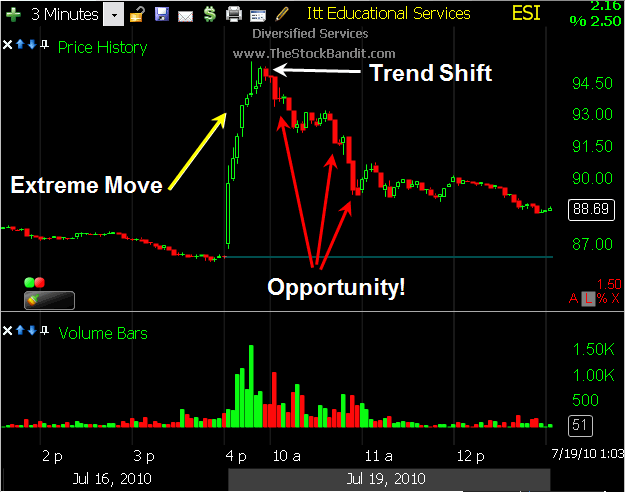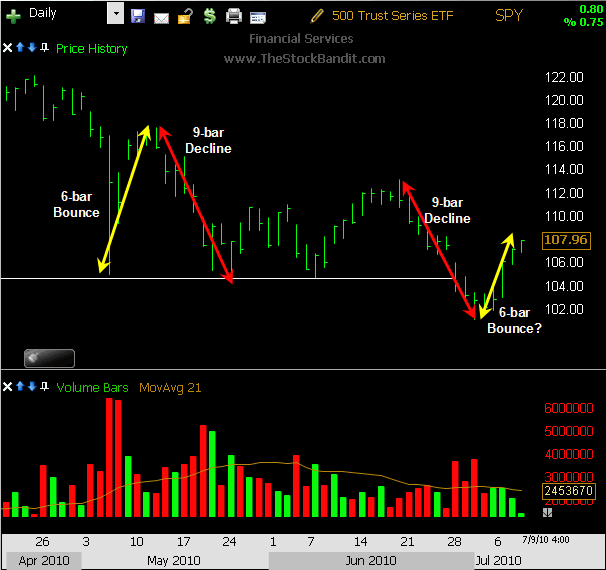Search Results for 'traders'
GS Getting Ready
Financial stocks are always on the radar of traders, and GS is usually at the top of the list. Interestingly, this one looks like it’s gearing up for a move of its own.
After undercutting support on July 1st, the stock began to grind higher, eventually taking out the late-June high on strong volume. Since then, a rising trend line from the low has served numerous times as support. Over the past several sessions, some narrowing consolidation has been seen with the creation of a small descending trend line just overhead. These two trend lines are now squeezing price in a pressure-chamber fashion, and one of them is about to give.
Typically when two trend lines are vying for control, the longer one tends to win out. In this case, that could bring an upside resolution to this pattern. In keeping with the recent market strength, that’s a distinct possibility.
I’m watching GS for a push through the trend line at $149.10 for a trade. Earnings have already been released, and this is a highly liquid stock. Could be good for a few quick points, but the buyers will have to emerge and push prices beyond the trend line in order to get it. An unfilled gap from April extends to the $160 area.
If instead the lower trend line is broken (currently at $145), that would be a failure of this bullish pattern and would leave the stock vulnerable to at least a partial retracement of this bounce.
Here’s a closer look for you:

Trade Like a Bandit!
Jeff White
Swing Trading & Day Trading Service
www.TheStockBandit.com
Are you following me on Twitter yet?
Bidding On BIDU
When trades come along which offer potential on multiple timeframes, I always perk up. If one timeframe doesn’t appeal to me, the other can still add to my account.
BIDU is one such setup right here. The channeling stock has been range-bound since early May, and a breakout may be coming soon from this rectangle pattern. Upper resistance is well-defined, offering day traders a quick-hit setup for an intraday breakout play. But with confirmation of a breakout – meaning, a close above that resistance level – swing traders also have a shot at a measured move to develop in the coming weeks for a $12 advance to the $90 area.
A breakout could come any day in BIDU, so I’ve got it on my radar for a trade if it can push through the $78.65 resistance area. This one doesn’t have a real clear-cut exit as a swing trade, so it isn’t one I’m planning to keep a long time… Just long enough to get paid and move on to the next idea.
Here’s a closer look for you:

Trade Like a Bandit!
Jeff White
Swing Trading & Day Trading Service
www.TheStockBandit.com
Are you following me on Twitter yet?
Intraday Extremes Offer Big Opportunities
The old adage says to ‘buy low and sell high.’ That’s misinterpreted by most, as they tend to sell their strongest stocks when strength is still present or buy before corrections are completed.
To the inexperienced, it may look like the move is done, but often times is followed by an encore of sorts. Timing is everything, indeed.
Extremes can really pay quite well. When fear is at its highest, it’s a great time to get long. And when everybody and their mom is making money, it’s certainly time to raise cash. But for the sake of this post, I’m not talking about buying a “generational low” or calling a long-term top in the market. In fact, I’m not even referring to the daily timeframe here.
I’m talking about how some of the best trades will happen at extremes…
…the kind which are found intraday.
Profit Where Others Fail to Look
Define it however you like, but at the heart of it, an extreme is approaching quickly whenever a move is unfolding at an unsustainable pace.
That might be a parabolic uptrend, or intraday capitulation. An extreme is a price spike which is showing exceptional momentum now, but the enthusiasm is beginning to fade, and soon there’s going to be a reactionary move.
That reactionary move is the one you and I can catch most often. I say that because once we see a stock that’s really on the run, the odds are that the easy money has been made for that particular move. Attempting to join the move means chasing price without a clear-cut exit plan, and that’s a huge no-no for any professional trader. So, the reactionary move is the money train for those who missed the original move.
What’s so funny is that most traders see a huge intraday run and just know they missed it. Don’t be as closed-minded as them. They drool over what it would have been like to be on board, and fail to recognize the opportunity that’s about to unfold. Dare I say, a more defined-risk opportunity.
You Missed the ‘Move’ – So What?
Take Monday for example. Education stocks bolted higher in the morning, ripping through offers on the way up as they painted the tape bright green. By the time most of us noticed them, they’d already put up very impressive gains.
Maybe you saw APOL, ESI, COCO, DV and others up in the neighborhood of 10% in just the opening few minutes. It looked like they could keep going, but suddenly the buying frenzy morphed into profit-taking, and thus, opportunity arrived.
RIG provided an excellent move for me (from Sunday night’s premium newsletter), but my most profitable trade of the day actually came in a short sale of ESI. Let’s take a look…
ESI ripped higher by $9 right off the open Monday, but I wasn’t long. It was up about $6 by the time I noticed it, and I’m not a buyer of that kind of strength. So instead, I waited for the enthusiasm to wane. And shortly after, it did.
The stock had painted a high of $95.62, and then backed off slightly. It spent several minutes consolidating, and then on the 3-minute chart I saw something noteworthy. I shorted at $95.10, set a protective buy stop up above, and waited to see if profit-taking would develop.
An hour later, the stock was more than $6 lower, trading in the low $89’s, and I was out of the last of my shares (after scaling out). It didn’t last long, but the overreaction on the upside was followed by a nice reaction on the downside, and that was the move that paid me.
Here’s a closer look:

I outline my entire method for trading these extreme reversals in my Advanced Trading Course, so the specific details are reserved for students, but I will give you a few general pointers here.
Profiting from extremes begins with a mindset shift. When you see a giant move, don’t kick yourself for missing it. Instead, start looking for a way to profit once it’s over. Be creative – the market requires it!
Take note of intraday extremes. Don’t chase them, just watch them. See if the pace of the move begins to slow down, and at the first sign of a turn, you’ll know you’re looking at an opportunity. They will not all pan out, but the risk/reward associated with them makes them well worth studying, and often times quite lucrative to trade.
Trade Like a Bandit!
Jeff White
Swing Trading & Day Trading Service
www.TheStockBandit.com
Are you following me on Twitter yet?
Three Pillars of Risk Management
As a Seinfeld fan, I really enjoyed The Fatigues episode where Jerry dates a woman with a mentor. George needs to give a report on Risk Management, and passes off the task to Jerry’s girlfriend so she can read all about it and save George time.
But Costanza isn’t the only one who doesn’t fully understand Risk Management. In fact, far too many traders struggle with this very topic, and it keeps them from surviving and from succeeding.
So, let’s look at 3 pillars of risk management as a way to keep it simple. If you can nail these down, you should be alright.
Protect Capital
This is a biggie, no doubt about it. Simple on the surface, but not easy to put into practice.
As traders, our capital is what keeps us in business. Ignoring the consequences of mismanagement is a major mistake that’s not easily recovered from. Those who fail to understand the importance of first preserving what they have tend to place profits ahead of protection. That leads to the age-old error of eyeing new trades with only potential gains in mind, rather than placing equal importance on potential losses if the trade fails.
Capital comes in two forms…psychological capital and trading capital. Both must be protected with vigilance.
Psychological capital is the amount of inner strength, confidence, and willingness to take risks that a trader possesses. It can be eroded through many mistakes, and it’s not easy to replace. Protecting one’s confidence as a trader is paramount to staying in this game, because the trader who’s unwilling to pull the trigger when good opportunities come along won’t ever win.
Trading capital is what’s available in your account, and it’s of course the type of capital most are familiar with. Money can be more easier to replace than confidence, but it’s still critical to manage risk in such a way that your account stays intact. Traders who disregard the importance of keeping an adequate capital base find out quickly they’re unable to profit big enough to matter, even when they’re right. So, try to maintain account highs as often as possible, and you’ll find your account is growing on a regular basis.
Trade YOUR Proper Size
This one will vary for everyone, so the secret is to make sure you’re trading position sizes which allow you to be at your best. That means avoiding trades which mean too much, both psychologically and financially. Let’s look at those one at a time.
Psychologically, the ability to recover from a loss is something we all must ensure. Taking a big hit from a trade which didn’t work out leaves us vulnerable to anger or despair, and neither are beneficial to our trading. Anger promotes revenge trades, and that typically leads to digging a deeper hole than that which we may find ourselves in. Despair leaves us so focused on our emotions that we fail to recognize good opportunities when they come along.
Financially, we never want to be trading so large that we can’t recover from a loss. Taking a fairly large position when you’re confident is one thing, but dumping your entire account into a single idea is another. Consider the math behind poor trades, for example. A 20% loss in your account will require a 25% gain to get back to flat. And the deeper that loss gets, the more that’s required to make it up. Taking several smaller trades instead of one big one might require more management, but it can also greatly help to avoid one major disaster.
Exit When You Know You Should
This sounds really simple, and it is, but it’s the follow through which makes this one difficult for some. Making a trading plan is one thing, but sticking with it can be another issue entirely.
It’s all about discipline, and that isn’t going to change. You know at which point you’ve stayed too long in a position and the time has come to kick it to the curb. All of us know what it means to blow stops, and most likely, it doesn’t pay off when we do. That’s a self-inflicted mistake that can be avoided, provided some measures are taken to help automate the process.
Here’s the thing…defined risks are the best kind. Pick your exit at the same time you select your entry, and commit to it. If you struggle with that, set a stop order the moment you’re filled on your entry, and then you won’t have to make a decision under the gun. If you get stopped, you most likely just saved yourself some additional pain. But you’ll be managing your risk effectively and reinforcing discipline even when you’re wrong.
If you’ll protect your capital, trade your proper size, and get out when you know it’s time, you’ll be doing 3 of the things the most successful traders focus on. How can there be any downside to that?
Trade Like a Bandit!
Jeff White
Swing Trading & Day Trading Service
www.TheStockBandit.com
Are you following me on Twitter yet?
Watch for Timing Themes
 As a rule, no there is no specified timeframe which I refuse to trade. However, it is always a good practice to pay attention to developing themes in how the market is moving.
As a rule, no there is no specified timeframe which I refuse to trade. However, it is always a good practice to pay attention to developing themes in how the market is moving.
For instance, (and this changes periodically, hence no hard-set rule), not long ago the market was in a bit of a routine of not doing much for the opening hour or so, and then finally we’d pick a direction and make a move. When I began to notice that, I’d get extremely picky with which trades I’d take in the opening hour. Once that routine changed and we started seeing cleaner moves right after the opening bell, I was again willing to trade whatever happened to be on the move.
Listen With Your Eyes
There are always timing themes you can pick up on if you watch closely. An obvious one is that it’s common to see stocks get quiet around the east coast lunch hour as traders step away, so that’s a good time to stay pretty quiet with your trading. Sometimes we’ll settle into routines of making big moves in the final 30-45 minutes of the day, offering some nice potential late in the session.
Just keeping a close eye on these kinds of things, or keeping a trading journal will help you to identify common behaviors of the market and notice times to stay away or be more active. Stocktickr has a time of day feature which will tell you which times of day are best or worst for you, among many other stats it’s able to generate, which makes it a great tool to check out if you haven’t already.
Here and Now
One thing I’ve paid attention to lately is the rhythm of the market moves. The market has been volatile and very reversal-prone, and yet there has been some order to it if you look a little closer.
Taking SPY as an example, we’ve seen several moves take place, both on the upside and downside, of similar duration and size in the past couple of months.
For these examples, I’ve counted the bar where a low or a high is set as bar 1, and have used the final bar of the move as my total. In the chart below, we see from the flash-crash May 6th low, there was a 6-day bounce before a reversal kicked in. And from the July 1st low, we’re now sitting on a 6-day bounce (through last Friday).
We’ve seen a pair of 9-day declines as well, starting from May 13th and ending on May 25th, and another from June 21st to July 1st.
Here’s a closer look for you:

Paying attention to the size, duration, and general rhythm of prices carries tremendous benefits to you as a trader. Watching for chart patterns is a great place to start, but don’t just stop there. Study price moves closely, and see where it gets you.
What have you noticed lately?
Trade Like a Bandit!
Jeff White
Swing Trading & Day Trading Service
www.TheStockBandit.com
Are you following me on Twitter yet?
Video Review of the Indexes 7-11-2010
The buyers went 4-for-4 last week with the major averages recovering what had been lost in the previous week of relentless selling. And for a holiday-shortened trading week, the action was quite good from start to finish.
Traders should be returning to their desks this week, and just in time for the start of earnings season and options expiration. Needless to say, we’re going to need our best, so it’s time to prepare once again for whatever the market brings our way.
As we head into a brand new week of trading, let’s examine some important levels to keep an eye on in the days ahead. That will have the greatest influence on how individual stocks are going to move, so it’s where the trading week begins.
This clip was also posted over on the Trading Videos site (as always), and perhaps you’ve seen it there – but in case you didn’t, I wanted to put it here on the blog for you.
Let me highly suggest clicking the “HD” on the video player and then going full-screen for best quality.
Trade Like a Bandit!
Jeff White
Swing Trading & Day Trading Service
www.TheStockBandit.com
Are you following me on Twitter yet?
Making it Back
Anytime the market makes as big and consistent of a run as it did from March 2009 to the April peak, there’s a growing confidence that invites new money to the game. Those who were completely spooked in early 2009 saw an impressive rebound, not only in prices but in their willingness to participate.
Of course, the longer in the tooth a rally becomes, the closer the end of it naturally gets. That’s unfortunate for some, but it’s simply the nature of risk in the market. After all, those who step out on a limb first will stand to make the most if they’re proven right, while others who wait for more of a sure thing may be among the last to the party right before it ends.
It’s natural for someone who buys at or near the peak to quickly find themselves underwater, and at this point just a short time removed from the April highs, there are no doubt many folks who were late to the party now feeling serious pain.
That feeling of panic has set in for them, and in most cases, there’s no exit plan. The failure to designate a safety net prevents level-headed execution of a game plan, so now they’re forced to think fast in the heat of the moment, sparking a slew of potential mistakes. Making it back now becomes the primary goal, as if there’s something magical about getting out unscathed. Nevermind the fact that the entry was made in hopes of turning an actual profit.
Exaggerating Errors
Traders face this dilemma on every timeframe when in a bad trade. With a negative P&L on the day, week, month, or year, the focus turns from sticking with a strategy to doing anything that might get them out of the hole – and fast.
Along with this mindset comes an urgency factor which may not have been present before – uh oh! The sudden recognition that they might be perceived as having been wrong strikes fear in their hearts and now the race is on to erase the losses.
I’ve been there plenty of times, and it’s no fun. But over the years, I’ve found several ways to reduce the impact of my errors. Here are a few things I try to do when I find myself underwater:
- Slow down. Often times the desire to just get into anything that might be moving means it’s also easy to overtrade. Spinning my wheels won’t help my P&L, and it sure won’t help my objectivity.
- Get selective. Rather than jumping quickly on anything that comes along, I’m going to be much more effective if I wait for the cream of the crop to surface. Waiting for the best risk/reward opportunities to arrive means passing up many other plays along the way, and returning to holding a high standard for where my capital is allocated.
- Trust your method. Some stretches of trading are better than others, absolutely. At times it’s extremely frustrating, while other times it feels almost easy. So there will be ups and downs, but over time my method has served me very well. When I find myself with the wrong color P&L, I remind myself that I’ll eventually get my groove back, so long as I don’t stray far from my style. As they say here in Texas, “dance with the one that brung ya.”
Translation for Timeframes
On a day trading timeframe, it can be tough to take a few hits early in the session. Your confidence gets quickly shaken, and you wonder whether it’s just a tough start from which you can recover, or if instead it just isn’t your day. The key is to avoid emotion-based decisions, which will lower your standard for trades and shift your attention to the money rather than the price action. Never do you want your losses to cause you to force trades, so if that’s your primary motivator, get away and return another day. If instead there are still ample opportunities for good trades, patiently wait for the best risk/reward setups and then make the most of them.
For a swing trading timeframe, streaks will happen where at times it seems you’re on the wrong side in every trade you place. Making it back will take a little longer, but it can be done if you’re methodical about it. Cut down your size immediately while you wait to find your groove, as that will slow the pace of your losses if you continue to time trades poorly. Become selective, because confusion can set in quickly if you aren’t following a clear strategy with a known objective. Patience will be crucial, but it can pay quite well, too.
Finding yourself down in a hole is no fun, but it’s a reality of trading that each of us will face from time to time. So take a long-term view with your trading career, even if your timeframe for each trade is quite short-term. Doing so will keep you level-headed when it’s the hardest, and it’ll make you tougher and better as you find your way back on the right side – and you will!
Trade Like a Bandit!
Jeff White
Swing Trading & Day Trading Service
www.TheStockBandit.com
Are you following me on Twitter yet?





